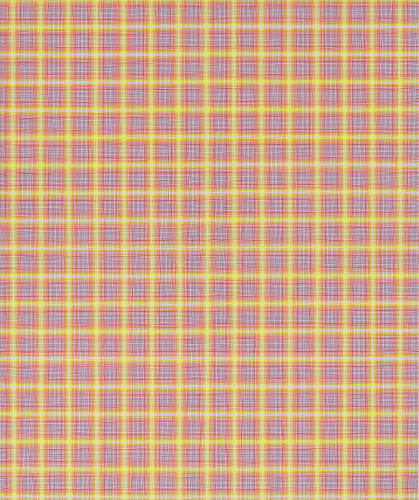Clothes enclose our bodies like a filter. Clothes reflect our spirit and the culture we live in.
– Caetano de Almeida
The bright fuchsia red colour is unusual but the patterning is a clear allusion to coffee-house chairs and their woven cane seat panels. The characteristic grid-like patterns in the small-format acrylic paintings evoke a world of ease and elegance, of fragrant coffee, leisurely conversations and rustling newspapers. And yet there are irritants here that go beyond the vibrant colour. The painted mesh is deformed, torn even, and there are gaping holes.
Caetano de Almeida’s works are shot through with patterns and complex structures which the Brazilian artist is a master in translating into painting – be that in his images of woven cane, of semi-transparent, often brightly coloured bands of household linen and other textiles. The canvas is the loom on which his brush and acrylic paints weave intricate patterns, and where technical precision and intense colour come together. These works express not only the artist’s love of mathematics, but also his great passion for fashion and garments, and his profound interest in social issues.
One of Brazil’s best-known international artists, Caetano de Almeida was born in São Paulo in 1964, and raised in Campinas, a large city some 60 miles to the north of his birthplace. Campinas held little inspiration for the youth who was hankering for cultural stimulation. Instead, he began to immerse himself in books and encyclopedias, and became intrigued by mathematical problems, paradoxes and intelligent puzzles, and by the construction of spaces and reflections. A seminal reading experience was Edwin A. Abbott’s novella, Flatland, a satirical essay on mathematics and Victorian society published in 1884. The artist’s fascination with mathematical constructions is the common thread that runs through all his works. Of himself he has said that he paints like a mathematician seeking to formulate a particularly elegant equation.
Alongside the exact science of mathematics, de Almeida’s work has also been strongly influenced by the scintillating world of fashion. He has always been attracted to Brazil’s colourful traditional dresses. When he travelled to study in Paris and India as a young artist, he immersed himself in the world of fashion and its countless sophisticated codes on the banks of the Seine River. On the Indian subcontinent, he came across garments whose colours enchanted him and that held clues to the wearer’s social position. Caste-specific patterns and fabrics still remain in use in India’s strictly hierarchical societies and the garment as a cipher or code continues to interest de Almeida: ‘Clothes,’ he says, ‘enclose our bodies like a filter. Clothes reflect our spirit and the culture we live in.’
Caetano de Almeida lives and works in São Paulo, Brazil. He graduated from the University of São Paulo as a Master of Fine Arts in 2005; his works have been shown at major art galleries and museums in Europe and the U.S.
Greatly appealing, yet challenging as well, his pieces combine the artist’s delight in colour and great technical virtuosity. Working free-hand from his pencil drawings, de Almeida patiently and painstakingly creates paintings of filaments, threads and weavings that are testament to the utter dedication that he brings to his art.
His textile paintings, finally, also express de Almeida’s profound interest in the history of art and culture. His focus on precise structures, rhythmic repetitions and colour grids harks back to Constructivism. Even so, the Brazilian painter is something of a ‘black sheep’ in that venerable school given that his delicately ‘woven’ patterns frequently feature gaping holes. There is a two-fold function to such deliberate lacunae. For one thing, they underscore the painterly perfection of his work and they may also inspire reflections on the resilience of our social structures.
Alice Henkes

